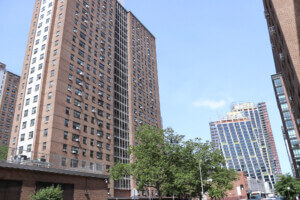Vienna’s Museum of Applied Arts (MAK) was inaugurated in 1871. It occupied what was formerly a drill field on the Stubenring—part of the city’s innermost ring road—and designed in a Renaissance Revival style by Heinrich von Ferstel. It remained in this state until World War II, when the building was partially damaged. By the 1990s, the MAK set about making its footprint more visible in the city. The museum’s focus on commissioning art in public space, often in engagement with the building’s facade, has included work by luminaries such as Donald Judd (Stage Set, 1991), Philip Johnson (Wiener Trio, 1998), James Turrell (MAKlite, 2004), and James Wines/SITE (Tor zum Ring, 1992).
Wines’s installation removed a section from the building’s primary elevation and placed it atop the stone sidewalk. This removal functionally allowed for an additional entrance as a proposal that preserves a fragment of the existing historic building. (A proposal to “cut a new bookstore entranceway into an exterior wall of the M.A.K. building was rejected on the grounds that it would violate an important historic institution,” Wines shared.) Wines described the “intrinsic extension” from the artwork’s original context as unique to the museum’s public art program. He offered that the element can be understood as an act of preservation, a work of public art, and a reminder of its architectural origins.

In 2017, Viennese architects Susanne Zottl and Daniel Kerbler were asked by the Burghauptmannschaft Österreich (BHÖ), an entity of the Austrian Federal Ministry of Labor and Economy that oversees architectural preservation, to design a barrier-free entrance to the MAK at the entry behind Wines’s piece. Zottl told AN that the only existing “accessible” entry to the MAK did not actually meet minimum accessibility requirements, which was not surprising given that its main function was a delivery entrance. This entrance also took visitors into the basement rather than the ground floor where other attendees enter, meaning it did not provide equal access.
The entrance through the opening left by Wines’s facade extraction was no longer in use by this time, and its stone steps were far from accessible. In a comment to AN, MAK director Lilli Hollein said that the construction of the barrier-free ramp was “long desired.” (Hollein became director in September 2021; Christoph Thun-Hohenstein was director for the preceding decade during which the ramp was built.) Hollein clarified that after extensive discussion between the architects, MAK, City entities, the Federal Monuments Office, and the BHÖ, the only entrance for the construction of a barrier-free entrance near the primary entrance, as Austrian law requires, was behind Tor zum Ring.

In 2020, the architects proceeded with a design that extends a straight ramp from the level of the interior floor down to the exterior sidewalk. A pool-like concrete pad swoops below between plain metal railings, while short, metal wall sections rise up from the concrete closer to the entrance itself, adding solid structure in the line of sight between Tor zum Ring and the historic building and establishing a similar geometry to the concrete base below. Zottl and Kerbler also completed accessibility work on the interior, including the installation of an elevator that connects the ramped entrance to the museum’s Main Hall and the removal of a “non-historic” piece of the building’s ceiling inside of the entrance, leaving a higher ceiling open to wider views of Wines’s sculpture.
Wines told AN that “from some views, the heaviness and inappropriateness of the new ramp totally eliminate all viewer access to the integrative purpose of this public art piece, the opening to the bookstore and the relation of the extracted section to the historical features of the MAK’s architecture.” He was not consulted throughout the process of making this improvement to the MAK. “This intrusion destroys most of the important views of this project’s intended connection between the extracted wall section and the free-standing fragment in the plaza,” he said.
Apart from spatial considerations about the area around the artwork, Wines, who is 91, is the target audience of a barrier-free point of access. He wrote: “As a handicapped person myself, with a total understanding of the need for ramps, I could have (if consulted) provided the museum and Vienna community with knowledgeable advice on a lightweight and visually unobtrusive choice . . . and one that would have been even more functional than the currently selected facility.”
Zottl felt that the design work respectfully addressed Tor zum Ring. She told AN that the “ramp honors the sculpture.” The architects’ approach was to “wind” the ramp around the sculpture in a way that left the sculpture as much room as possible while meeting legal accessibility requirements. Wines described the design approach as a “grotesquely intrusive choice” and wondered why the government agencies involved did not contact him regarding the project. Zottl told AN that the team, unsuccessfully, tried to get in touch with the office of the late architect who drew the plans for the original bookstore entrance and did not know if MAK had contacted Wines. Wines said that he only learned of the project after its completion.

Wines hopes the City would allow him to propose an alternative ramp, as he thinks it is possible to design a ramp that is less obtrusive. “I am sure that all art works in the MAK collection are protected from even the slightest scratch,” Wines wrote in a letter to Vienna mayor Michael Ludwig provided to AN, “so, why hasn’t this work of public art received comparable respect?” Ludwig later said that “his office and related agencies in the city had nothing to do with the intrusive ramp,” according to Wines.
While Wines’s and the architects’ aesthetic appreciation of the extant ramp may differ, the scenario seems to be largely one of missed opportunities, principally that a museum that prides itself on public art installations did not contact a living artist before altering the site of their work, which could have precipitated a fruitful second collaboration between Wines and the MAK. Hollein told AN that “the relationship with artists, their work and especially the dialogue that is empowered between the public and art and the museum via public art projects is highly valued by the MAK.” While Zottl approached the design with respect to Wines’s work, Hollein told AN that “the project would maybe not be executed in this way” under her directorship.
Wines lamented that while many works by his studio SITE have been torn down or altered over the past 20 years, Tor zum Ring has always remained well-preserved. Because of his age and health, the circumstances surrounding its new nearby ramp have left him “doubly depressed and feeling totally dishonored.”











